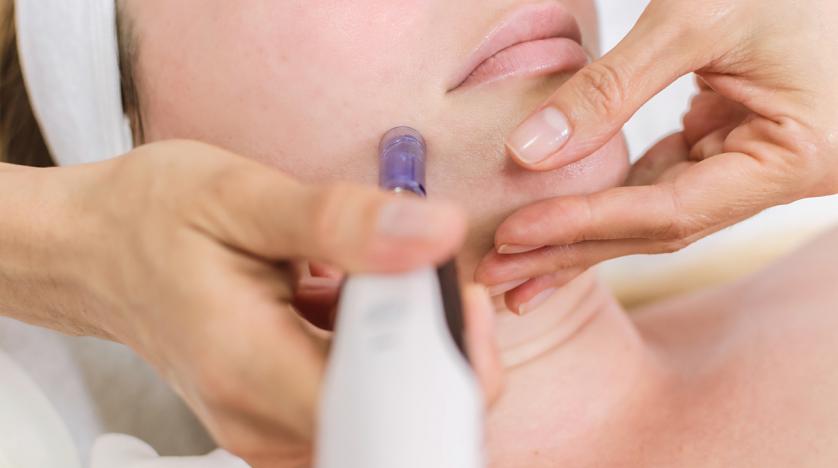Needling Your Way to Healthier Skin

Reuters
If the idea of poking yourself in the face with tiny needles in hopes of improving your skin sounds a little bizarre to you, you're not alone. For years, the medical establishment looked at the practice, known as microneedling, with a leery side-eye.
"I didn't take it seriously until relatively recently," says Dr. Kenneth Arndt, medical editor of the Harvard Special Health Report Skin Care and Repair and a founding editorial board member of the Harvard Health Letter.
Microneedling, also referred to as percutaneous collagen induction, was first described in the literature in 1995. In recent years, not only has the technique gained acceptance, but it appears to have secured a place alongside mainstream treatments designed to improve the skin's condition and appearance. "In the last three to five years, there's been a lot more information, interest, and studies documenting what microneedling can do, as well as a lot of commercial development," says Dr. Arndt.
Microneedling has also grabbed the attention of consumers. "I think this is largely driven by social media, which makes procedures once hidden behind a physician's office doors now widely visible," says Dr. Johanna Riesel, a clinical resident in plastic surgery at Harvard Medical School.
A healing injury
Skin microneedling uses pen-shaped or roller devices armed with fine needles to make minuscule, evenly spaced punctures in the skin. The small wounds created by the needling devices, which sometimes allow a pinprick of blood to rise to the surface, induce the skin to start a wound healing response. The body rushes to patch up the injury by growing fresh collagen and elastin, says Dr. Arndt. Collagen and elastin are what give your skin its strength and ability to stretch and make it appear more youthful.
Microneedling is what is referred to as a type of fractional treatment, in which only a fraction of the surface of the skin is affected, leaving skin unharmed around each micro-wound. This allows for rapid healing and a short recovery time associated with the procedure, says Dr. Arndt.
"In our practice, we use microneedling primarily to treat fine lines and wrinkles, in particular perioral wrinkles, which are vertical lines that form around the mouth," says Dr. Arndt. It is also sometimes used in combination with other skin treatments.
The healing response triggered by the treatment can also improve scarring, including acne scars, and help reverse skin damage from the sun, says Dr. Arndt. It's sometimes used along with topical medicines and light to treat actinic keratoses, crusty precancerous lesions caused by sun exposure. There has been some anecdotal evidence that microneedling may be useful in combating hyperpigmentation, including difficult-to-treat dark patches known as melasma, but research is lacking to back up these reports, says Dr. Arndt. Others claim success in using the treatment to help to regrow hair in people in people with early balding. More studies are needed to determine how well microneedling works on various conditions, says Dr. Riesel.
The pros and cons of microneedling
In addition to stimulating the body to produce new collagen and elastin, microneedling can also provide a means of getting therapeutic products through the skin barrier, where they can work more efficiently, says Dr. Arndt. This is not only a benefit of microneedling, but also a caution. Applying potentially toxic substances to microneedled skin can enable them to be absorbed throughout the body and cause harmful reactions, so make sure you use only treatments that your doctor has specifically approved for this purpose.
Over all, microneedling treatments are considered very safe, and there have been few reports of adverse events related to the practice, says Dr. Arndt. It's also well tolerated by most skin types, including darker skin, and is typically less expensive than other similar treatments, such as laser surgery, he says. Microneedling can be uncomfortable, so your doctor may apply a topical anesthetic before treatment.
Microneedling is not a quick fix. Changes with microneedling take time, because your body is actually repairing itself and growing new tissue. Most people will also need a series of treatments — typically at least two or three, but potentially as many as six, spaced four to six weeks apart — to get the desired result.
And microneedling won't likely produce dramatic results, but rather mild to moderate improvements. Studies show that people themselves and objective viewers report seeing a 45% to 55% improvement to the skin six to 12 weeks after a microneedling treatment, says Dr. Arndt.
Latest News
 Security Council to vote Thursday on Palestinian state UN membership
Security Council to vote Thursday on Palestinian state UN membership Dubai reels from floods chaos after record rains
Dubai reels from floods chaos after record rains Khasawneh, Saudi Shura Council speaker discuss bilateral ties, regional developments
Khasawneh, Saudi Shura Council speaker discuss bilateral ties, regional developments Egyptian Foreign Minister condemns potential Palestinian displacement as 'war crime'
Egyptian Foreign Minister condemns potential Palestinian displacement as 'war crime' Travelers from Jordan advised to confirm flights amid Gulf weather turmoil
Travelers from Jordan advised to confirm flights amid Gulf weather turmoil
Most Read Articles
- King, Bahrain monarch stress need to maintain Arab coordination
- Dubai reels from floods chaos after record rains
- Security Council to vote Thursday on Palestinian state UN membership
- Khasawneh, Saudi Shura Council speaker discuss bilateral ties, regional developments
- Tesla asks shareholders to reapprove huge Musk pay deal
- Jordan will take down any projectiles threatening its people, sovereignty — Safadi
- Hizbollah says struck Israel base in retaliation for fighters' killing
- Princess Basma checks on patients receiving treatments
- Knights of Change launches nationwide blood donation campaign for Gaza
- The mystery of US interest rates - By The mystery of US interest rates, The Jordan Times